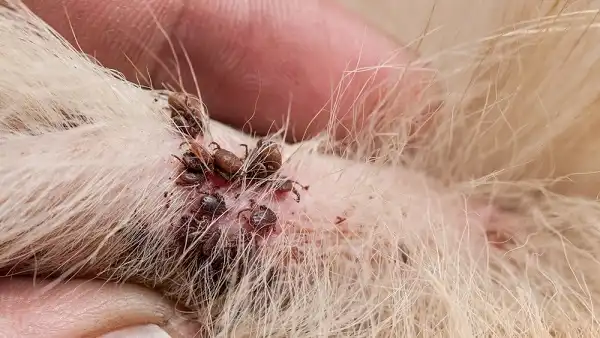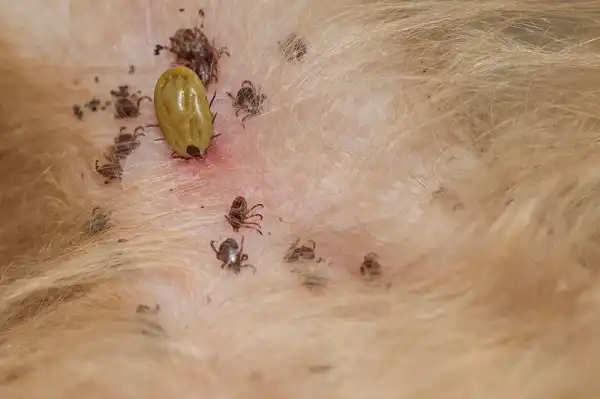As a pet owner, you know how much joy your furry friend can bring to your life. You’re probably also aware of the responsibility that comes with having a dog or other pet; specifically, ensuring they stay healthy and safe from any potential dangers. One such danger is tick infestations. They are very small parasites that hide in tall grasses and vegetation, waiting for an unsuspecting dog to pass by so they can latch on for a meal – usually blood! While it may seem like something out of a scary movie, a tick infestation is unfortunately all too common in dogs. In this blog post we’ll delve into the signs of and treatments for infestation by ticks – understanding these little critters will give you the tools necessary to keep your pup safe from harm!

Dog Tick Description
Ticks are small arachnids that can live in a variety of environments. They have 4 pairs of legs, and their bodies appear to be divided into two sections—the head and the body. Their bodies can range in color from brown to reddish-brown, depending on the species. The size of ticks varies as well; some may be no larger than a pinhead, while others may grow to be about the size of a pea. No matter the size, all dog ticks have eight legs and two sections – a head and body – that are separated by an indentation. Their bodies may be different colors depending on the species, often featuring shades such as brown or reddish-brown. Dog tick bodies can also appear smooth or mottled depending on the species.
Dog Tick Habitat
Dog ticks can be found in a variety of habitats, including grassy fields, wooded areas, and even within the home. They are often found in areas with tall vegetation where animals frequently pass through. In addition to these areas, they can also live inside the walls of homes and other buildings if there is a lot of moisture present. Dog ticks tend to prefer areas with moderate temperatures and humidity levels. They also like to stay close to their host animal, which could be either wild or domestic. This allows them to easily latch onto their host for feeding and easily hide after they have finished feeding.
Dog ticks are most active during the warmer months of the year, as they need warmth to survive and thrive. During this time, they will search for hosts in order to feed on blood meals from animals such as dogs and cats. To do this, ticks will climb up onto blades of grass or shrubs where their hosts may be passing by so that they can latch on when the opportunity arises. Once a tick has successfully attached itself to its host, it will suck blood from its victim until it becomes engorged with blood before detaching and hiding again in its environment until its next mealtime.
Dog Tick Diet
Dog ticks primarily feed on the blood of their host animals, such as dogs and cats. They use their small, sharp mouthparts to attach themselves to the skin and then feed on the host’s blood until they are engorged with it. While feeding, they can transmit diseases like Lyme disease and Rocky Mountain spotted fever to their hosts. In addition to blood meals, dog ticks may also consume other sources of nutrition in order to survive. This includes plant matter like leaves or grasses, as well as fungi and bacteria found in their environment. Ticks will also consume fluids from their hosts that may have trace amounts of nutrients within them.

Dog Tick Size
Dog ticks come in a variety of sizes, ranging from minuscule to visible to the naked eye. Adult dog ticks are typically about the size of a pea, measuring between 0.2 and 1.5 centimeters long. On the other hand, nymph and larval dog ticks tend to be much smaller, with larvae measuring just 0.1 to 0.3 cm long and nymphs only growing up to 0.6 cm when engorged with blood. The size of dog ticks can also vary depending on the species; for example, females of some species may grow larger than males due to their need for larger blood meals in order to lay eggs.
Dog Tick Lifespan
Dog ticks have a lifespan that can range from a few weeks to several years, depending on species and environmental conditions. The average adult dog tick will usually live between two to three months, while nymphs may only survive for a few days or up to a month. In order for them to reach the adult stage of their life cycle, they must feed on blood meals at least three times; if these meals are not acquired within the appropriate amount of time, the tick will die before reaching maturity.
The exact length of a dog tick’s lifespan is also dependent on environmental factors such as temperature and humidity. Dog ticks prefer moderate temperatures and humidity levels in order to thrive; if the conditions become too extreme, the tick’s lifespan may be shortened due to difficulty in acquiring the necessary nourishment for survival.
In addition to external conditions, certain species of ticks may also have longer lifespans naturally than others. For example, the American dog tick (Dermacentor variabilis) has an average lifespan of around 9 months with optimal environmental conditions, while the brown dog tick (Rhipicephalus sanguineous) may live up to two years under ideal circumstances.
Dog Tick Behavior
Dog ticks are known for their opportunistic feeding habits, as they will attach themselves to a host and begin feeding on its blood without hesitation. When seeking out a host, ticks often traverse tall grass or shrubbery in search of potential prey. They also possess hyper-sensitive sensory organs that allow them to detect chemical signals given off by their hosts; this assists them in locating the source of food more quickly and efficiently.
Ticks may also move around from one area of a host’s body to another if they feel disturbed or threatened during their mealtime. This behavior is known as questing, where the tick walks around with its front two legs extended in search of another suitable spot for attachment and feeding. If successful, the tick will then latch onto a new area of skin and begin its next meal; however, if unsuccessful, it will drop off onto nearby vegetation and wait until conditions become more favorable once again.

Dog Tick Speed
Dog ticks may seem slow and sluggish due to their eight-legged locomotion, but they are actually quite adept at moving quickly when necessary. While searching for hosts, some species of dog tick will engage in a behavior known as ‘questing,’ wherein they extend their front two legs outward and rapidly move across vegetation in search of potential prey. The speed at which these ticks can traverse an area is impressive; some species have been observed traveling up to 12 inches per minute when questing!
In addition to their impressive movement speed, while questing, adult dog ticks can also crawl up walls and other surfaces with ease. This is because they possess tiny claws on their feet that help them cling onto objects more securely; coupled with the fact that these parasites weigh only a few milligrams each, it’s no wonder why they can make such quick climbs!
Dog Tick Hunting
Dog ticks are opportunistic hunters, using their highly-sensitive sensory organs to detect chemical signals given off by potential hosts. They often traverse tall grass or shrubbery in search of prey and are capable of quick bursts of speed when questing for food. Once a tick attaches itself to a host, it begins to feed on its blood by penetrating the skin with its sharp mouthparts. If successful, the tick will then latch onto a new area of skin and begin its next meal; however, if unsuccessful, it will drop off onto nearby vegetation and wait until conditions become more favorable once again.
Dog Tick Potential Health Risks
Dog ticks are dangerous parasites that can transmit a variety of diseases through their bites. Some of the more commonly known illnesses associated with tick bites are Lyme disease and Rocky Mountain spotted fever. These conditions can cause long-term health issues if left undetected and untreated, making it important for pet owners to be aware of the potential risks involved with tick infestations. Lyme disease is caused by the bacteria Borrelia burgdorferi, which is transmitted through the bite of an infected black-legged deer tick or western black-legged tick. Symptoms may include fever, fatigue, headache, joint pain, swollen lymph nodes, a rash similar to a bulls-eye pattern around the bite area, and other flu-like symptoms. Left untreated, complications such as memory problems or heart issues can arise over time due to inflammation in one’s joints and brain.

Conclusion
Dog ticks are dangerous parasites that can cause a variety of illnesses if left untreated. They utilize highly-sensitive sensory organs to detect chemical signals given off by potential hosts in order to hunt for prey and attach themselves quickly with the help of their microscopic claws. Although they can move quickly, dog ticks are still susceptible to temperature or humidity extremes which could hinder their movement as well. Ultimately, understanding the behavior and potential health risks associated with these pests is essential in order to properly protect your pet from harm caused by tick infestations.
Frequently Asked Question


